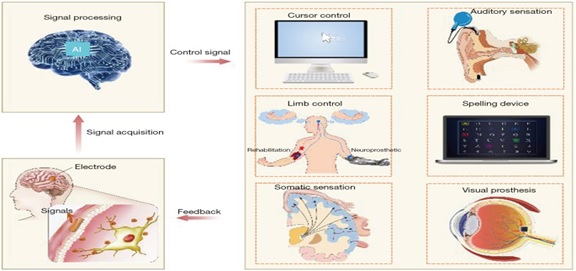Recently, there was news where we came to know that a paralyzed person had sent a message on Twitter to the world for the first time using his thoughts with the help of a brain computer interface.

Source: Morgan Housel on Unsplash
Philip O’Keefe, an individual aged 62, has been transplanted with a microchip “endovascular brain-computer interface (BCI) developed by neuroprosthetic startup Synchron.”
With the help of his thoughts, he posted the tweet on the twitter account of Thomas Oxley, Synchron,CEO.

How does it function?
The jugular vein in the neck is used to implant a node into the brain, which is then inserted under the skin in the chest, avoiding the need for drilling into the skull or open brain surgery. It catches up on brain signals and sits on the motor cortex, the region of the brain in charge of voluntary physical movement. A user can imagine which letter they want to enter by looking at a screen with a keyboard turned on, for example. A machine learning algorithm will next process the brain data and translate the signals into particular digital commands via a device worn on the chest (Source: www.iflscience.com).
The importance of machine learning cannot be overstated. This development is closely related to machine learning. ML techniques such as deep learning will be used in “feature extraction and classification of EEG and ECG signals.” The use of ML algorithms will reduce the noise, which is non-stationary, and convert the electric activity in the brain into meaningful signals.

Source: Alexandre Gonfalonieri

Source: Zhang, X., Ma, Z., Zheng, H., Li, T., Chen, K., Wang, X., Liu, C., Xu, L., Wu, X., Lin, D., & Lin, H. (2020). The combination of brain-computer interfaces and artificial intelligence: applications and challenges. Annals of Translational Medicine, 8(11), 712.
The process starts first with brain activity, i.e., the thought process and reactions happening in the brain, which are in the form of electroencephalograms (EEG). Here the signals and electrodes in the brain will join together. Next, the signals will be processed by an ML tool supported by artificial intelligence. Here the features are extracted through signal processing with AI and processed as a meaningful signal. Then the data will be decoded by the ML model by using classifications such as CNN and regression, which will process the data into text. Finally, the BCI-based application will transform the data into meaningful sentences just as spoken by the person. This is an evolutionary thing that makes individuals express the things that they can’t.
How does it impact marketing?
The combination of AI and BCI together could result in something like this in terms of customer experience. Let’s pretend you see someone on TV eating an ice-cream you like. Later, you discover a similar-looking ice-cream in a sponsored post while scrolling through your favourite social networking app. Because of certain automated content based on Generative Adversarial Networks, the person eating this ice-cream might look like you (GANs) (source: Alexandre Gonfalonieri). This is the power of BCI. So it helps marketers to understand customers better and to know what’s happening in their minds without any noise.
Important marketing data for firms like memory activation can be collected through BCI applications. It also helps marketers to “track customer journeys, sentiments, and preferences” (Akriti Parida). Because of this, marketers can come up with more tailored and personalised advertisements for individuals based on their thoughts directly into their brains.
Also, search engines can leverage the browsing patterns and suggest the pages or videos you want through BCI. Using this technology, music apps like Spotify, Gaana, and Wynk Music can suggest or play songs based on your mood. OTT platforms like Netflix and Amazon Prime can suggest movies or web series based on your thoughts. Even organisations can collect the brain data from third-party applications about you and can come up with strategies aimed at an individual level. As a result, brain data will be an extremely strategic data source for marketers in the future.
Conclusion
The commercialization of brain data in the consumer market, as well as the development of devices that interact with BCIs, will have an impact in the next few years. To make this happen without any flaws, there is a need to create more reliable and consistent algorithms that are simple to train and deploy. Algorithms must be able to deal with noisy signals, work with small training samples, generalise on users over time and mood, and generalise across users.
Prof.Ganesha K.S
Assistant Professor
DSCE-MBA
